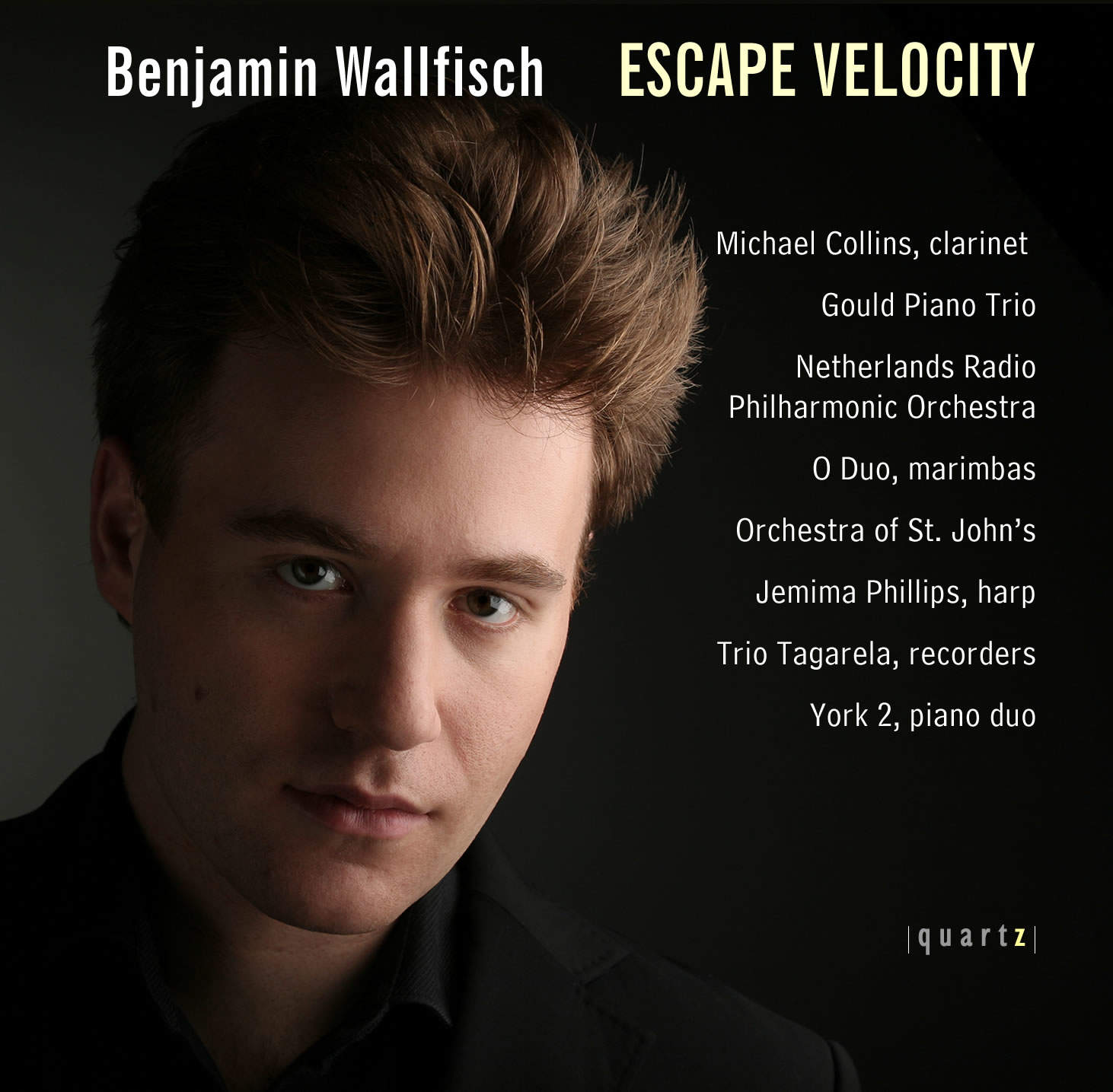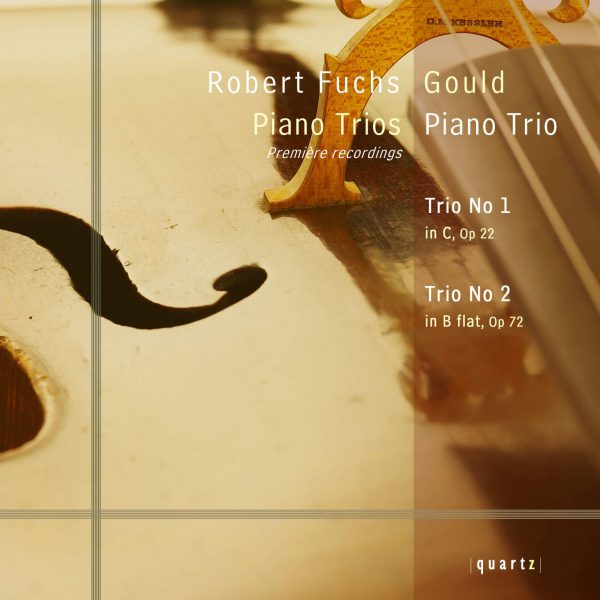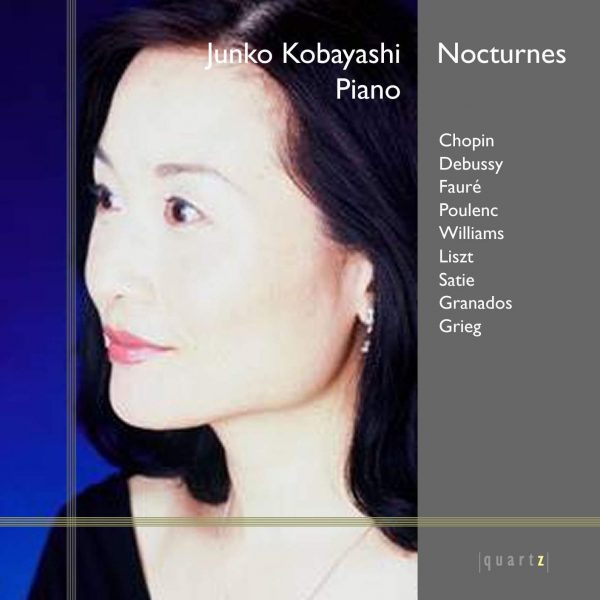Escape Velocity
Price range: £4.99 through £11.99
Escape Velocity
Concertino
Spectra
Speed
Trio
Requiem
Impulse
Nocturne
Michael Collins, clarinet
Gould Piano Trio
Netherlands Radio Philharmonic Orchestra
O Duo, marimbas
Orchestra of St John’s
Jemima Phillips, harp
Trio Tagarela, recorders
York 2, piano duo
About This Recording
John York writes:
Described by Humphrey Burton on BBC Radio 3 as “a major new name on the new music horizon”, Benjamin Wallfisch’s fast-growing list of large-scale orchestral, vocal and chamber works shows him, at the age of 27, to be a serious composer for our times. Over thirty works have been commissioned to date. A 2005 commission from Netherlands Radio Philharmonic Orchestra was the genesis of the symphonic movement entitled Speed which displays the juxtaposing of extremes in Benjamin Wallfisch’s language “great energy contrasted with slow-moving, long-breathed and yearning melody. His first String Quartet was composed for the Belcea in 2001, followed by a second for the Coull. His works outside the concert hall include a major ballet score entitled 21, commissioned by the Rambert Dance Company and premiered at London’s Sadler’s Wells, and a feature film score for Thomas Vinterberg’s and Lars von Trier’s Dear Wendy, nominated as “Discovery of the Year” in the 2005 World Soundtrack Awards. From his Opus 1, the luminous and glistening Sudden Light (commissioned by the Manchester Camerata), to his latest works including the stratospheric Escape Velocity, a piece which received its premiere the 2006 BBC Proms, there is a consistent, compelling integrity and a palpable, powerful personality.
He begins a new work by building a strong idea of its overall structure into which he feeds ideas and ‘elements which all share the same DNA’, and where everything, from the overall rhythmic impetus to the tiniest melodic cell, justifies its existence through its place in a complex network of interconnections. Characteristically, he places emotion at the core of the music, along with a clarity of message that must be communicable, and he taps into a rich and instinctive vein of melody which is both attractive and challenging. Ben’s music is, by design, vivid and disciplined, passionate and intense.
He has also built an important parallel career as a conductor and believes that conducting, just like composition, is creative, working to achieve a clearly defined vision that must be communicated with respect and conviction.
2006 John York
Benjamin Wallfisch writes:
If an object is propelled upwards with such extreme initial velocity that as it rises gravity cannot slow it enough to reverse its ascent and the object completely escapes Earth’s gravitational field, it is said to have been propelled at Escape Velocity. This concept lies at the core of this piece for string orchestra, piano, celesta, harp and percussion, in which a solo violin is the “object” eventually propelled by the velocity steadily accumulated, intensified and released by the rest of the orchestra. In the opening section, gentle waves of dispersed yet volatile energy sweep through the orchestra interspersed with a tranquil solo violin. A momentary explosion briefly indicates the true scale of potential velocity contained within these as-yet diffuse waves of energy. The chorale which forms the main voice of the central section acts to steadily intensify and focus this potential velocity. As the harmonic language and texture gradually become more complex, a chain of events is set in motion which induce an exponential rise in tension and the focus of all accumulated energy into a single incandescent point before its full scale is unleashed in the final section, propelling the solo violin into orbit in the closing moments.
It is well know that the clarinet’s enormous potential as a solo instrument in terms of its ability to achieve incredible contrasts of dynamics and articulation, and in particular to rapidly move effortlessly between the extremities of its range, is almost unrivaled among woodwind instruments. In Concertino I have simply gone about to embrace this potential as far as possible, involving the orchestra very much as partner of, rather than accompanist to, the soloist. It was written for and is dedicated to one of the great virtuosi of the instrument, Michael Collins.
In parts of both first and third movements of my piano quartet Spectra, the piano performs long successions of harmonic clusters, each one often containing a near full chromatic spectrum vertically and, when put next to each other as a progression of harmonies, create a separate horizontal spectrum of colour. Although the idea of the convergence and interplay of both horizontal and vertical chromatic spectra lies at the heart of much of the harmonic language of the piece, it is put below the surface of the work’s material. At the surface, we find the rapid piano gestures and cantabile string lines in the first part of the opening movement introducing much of the melodic material of the rest of the piece, a second movement influenced in part by gypsy folk music, an interaction of recitativo solo passages and playful scherzandi in the third movement, and a Finale driven by the dance. Spectra was commissioned by Lake District Summer Music with the support of the RVW Trust and the Britten Pears Foundation.
Speed was commissioned during my two-year tenure as Assistant Conductor of the Netherlands Radio Philharmonic Orchestra. During this time I got to know the sound and working method of this orchestra very well and was in fact given the wonderful and unusual opportunity to workshop the early sketches of the piece with the full orchestra nearly a year before the actual premiere. The piece is in three main parts: the activity of the two outer sections (which give the piece its title) is balanced by the calm of the slower central section and the brief tranquil coda.
Having not written for recorder before, when I started working on Trio I was amazed by the extraordinary array of colours and textures the instrument is capable of, particularly as an ensemble of three. The piece is conceptually based on two simple ideas: the number three and its permutative effect on the work’s overall structure (on both micro and macro levels), melodic shape and rhythmic construction; and the notion of a progressive clarification or purification, whereby layers of complexity are gradually removed to bring into focus at the very last moment the three-note melodic cell on which the entire piece is built.
My grandmother, Anita Lasker-Wallfisch is one of the strongest women I know. She is also one of the most loving and generous. The story of her survival of the Holocaust through playing the cello in the camp orchestra at Auschwitz and then surviving Bergen-Belsen is well known. Her parents, my great-grand parents, Alfons and Edith Lasker did not survive. Requiem is dedicated to their memory and is performed here by three generations of cellists in my wonderful family: my grandmother, father and brother.
I have a great love of jazz and in particular its rhythmic language and Impulse is simply a five-minute exploration of this for piano duet and two marimbas.
I have for a long time been fascinated by the rich sound-worlds the harp can create. When I was asked by London City Showcase to write a short piece for Jemima Phillips, official harpist to HRH The Prince of Wales, I decided to explore and augment these sound-worlds through having the live harp performing alongside a tape part constructed entirely from specially-recorded harp samples (also performed by Jemima). In Nocturne one of my principle aims is for the live harp part to blend with the pre-recorded digitally-altered harp material in such a way so as to make the listener unaware of the distinction between the two.
©2006 Benjamin Wallfisch
Track Listing
-
Benjamin Wallfisch
- Escape Velocity
- Concertino (I)
- Concertino (II)
- Concertino (III)
- Spectra (I)
- Spectra (II)
- Spectra (III)
- Spectra (IV)
- Speed
- Trio (I)
- Trio (II)
- Trio (III)
- Requiem
- Impulse
- Nocturne




